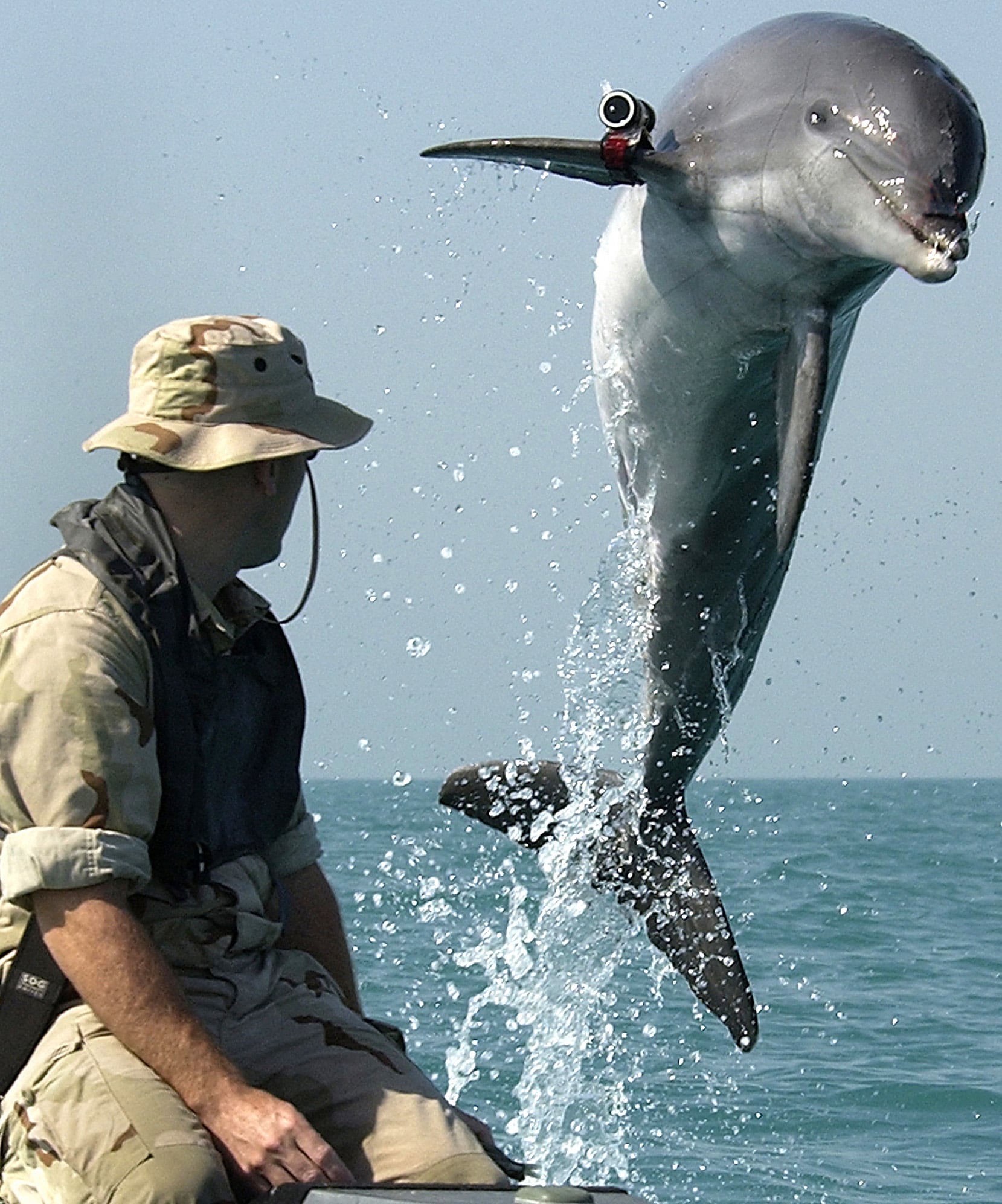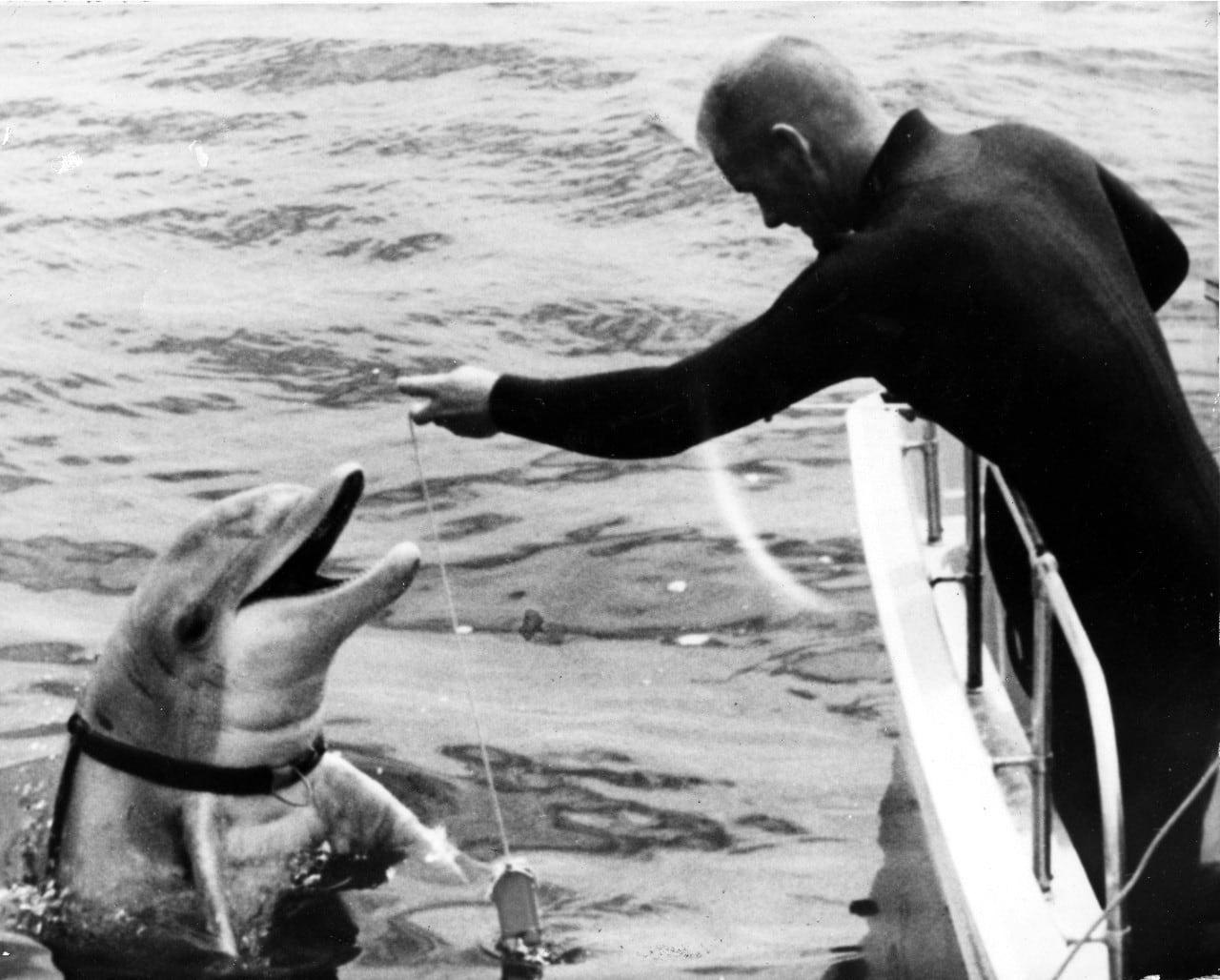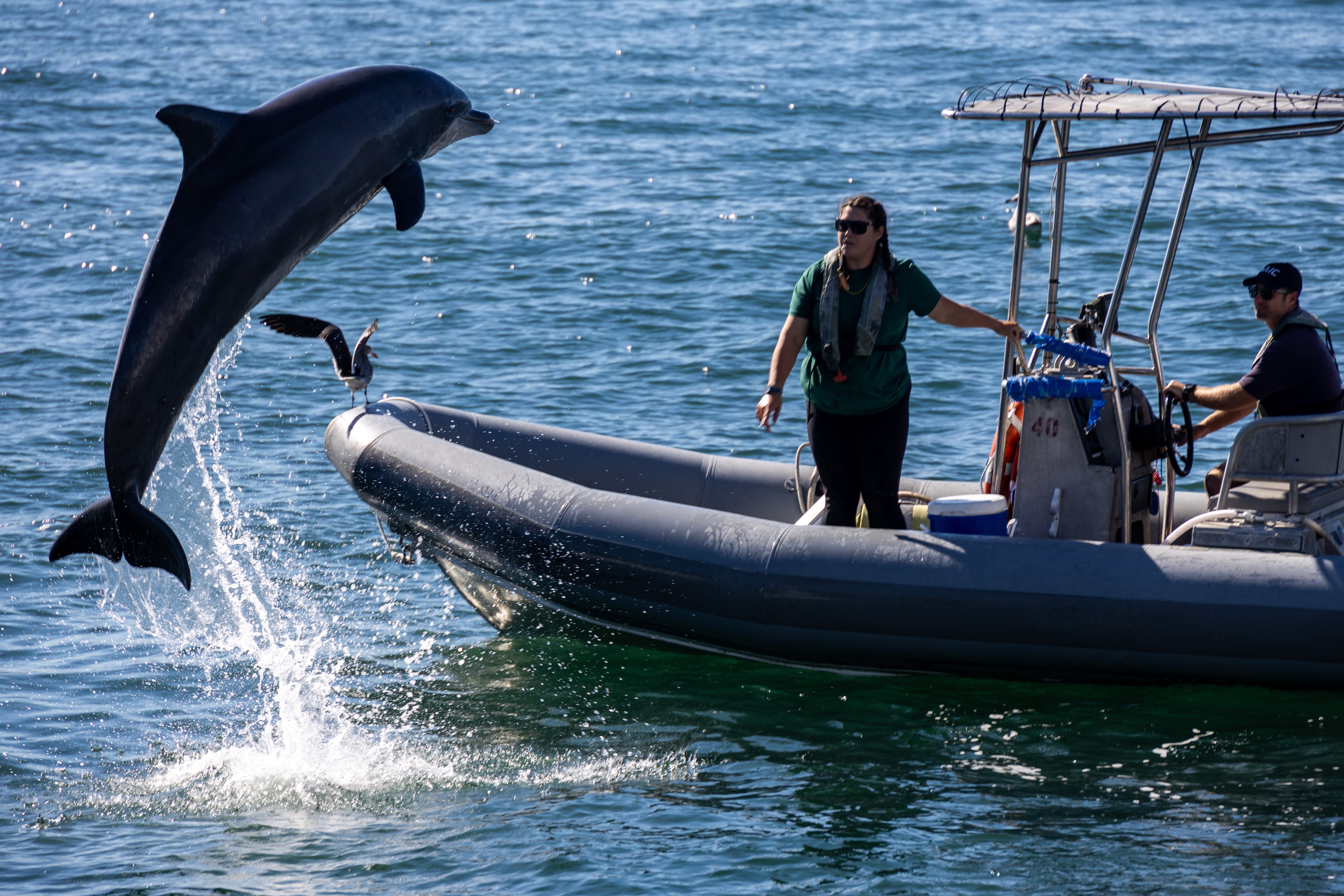SAN DIEGO – In 1959, the Navy stood up its Marine Mammal program here. With one dolphin, researchers set out to study how fast the creatures could swim, in an effort to improve ship and torpedo performance.
Sixty-five years later, the program has roughly 120 sea animals that are trained to detect mines and other underwater hazards.
Today, the program also stands at the forefront of research into dolphin bio-sonar and best veterinary care practices for the creatures, Dr. Mark Xitco, the program’s director, told Navy Times during a visit to the dolphin enclosure at Naval Base Point Loma in February.
Recently, the program has also taught sea lions how to play video games, part of an effort to better understand cognitive enrichment within the creatures. The voluntary gaming sessions come with plenty of herring rewards for a job well done.
On a sunny morning, dolphins swam about and occasionally scampered and jumped into the air as a team of handlers fed and worked with the animals.
The program’s scientific side was showcased in a 2023 New York Times report exploring the program’s work on the science of dolphin aging, told through the lens of Blue, a 57-year-old Navy dolphin.
But when it comes to operations, Xitco said the program trains Navy animals “to do simple things under extraordinary circumstances.”
“For them, detecting enemy divers and swimmers or (underwater drones) or enemy mines, finding the target is easy,” he said. “The animals are natural hunters, we just change what they’re hunting for.”
The Marine Mammal Program is largely recognized for advances in the field of marine biology, according to Jim Dines, a biological sciences professor at California State University Long Beach.
Dr. Sam Ridgway, a former leader of the program, is largely considered to be “a founding father of marine mammal medicine,” Dines said in an email.
“At the same time, the marine mammal research community has mixed feelings about keeping dolphins and sea lions in captivity, and some have even stronger feelings about using these marine mammals in service of the military’s mission,” Dines said.
Dines likened the different perspectives to how the research community feels about marine parks and aquaria that also keep mammals in captivity.
“There is a recognition of the value in the research, education, and rescue/rehabilitation that most of the marine parks are engaged in, and simultaneously be uncomfortable to infuriated that intelligent animals are held in captivity for human entertainment and for profit by the corporations operating these parks,” he said, adding that “there is wide variation in personal views” on the matter.
Xitco said the animals receive the highest quality of care, and that that care is mandated by a Navy Secretary-level instruction.
“Not high care, pretty good care within budget,” he said. “Highest quality care.”
The Navy’s Marine Mammal Program is the second-largest holder of marine mammals in the United States, after Sea World, Xitco said.
“We never put any Navy animal in any harm’s way any more than our personnel,” Xitco added. “We go together, and it’s a tough job that we’re doing, but we don’t do anything on the backs of the animals.”

Each dolphin has a primary and secondary handler, part of a team of roughly 200 personnel looking out for their wellbeing, as well as nearly 20 veterinarians on standby should the handlers notice anything off about their animals.
The Navy has led the way in the marine mammal field when it comes to dolphin wellness, Xitco said.
“All of our animals are trained to participate in their own health care, they sit still and let us look at every orifice and body part, and the Navy invented that,” he said. “Back in the 60s, we were the first ones to train a dolphin to voluntarily give a blood sample … and then we sort of spread that philosophy throughout the marine mammal community, and then marine mammal trainers spread it to throughout the zoological community and even into our domestic pets.”
Xitco said one of the most challenging parts of the program involves getting dolphins comfortable out of the water when being transported in trucks, ships, airplanes or by helicopter.
Such training can’t be rushed along on any human timetable, he said.
“There’s no way we can rush it, because at the end of everything we do, we release the animals and rely on them to be cooperative partners with us out in the ocean,” Xitco said. “So if they weren’t comfortable and confident in what they do with us … they would just leave and not come back, and they almost never do.”
Scientists here study the dolphins’ biological sonar array, a system that man has yet to replicate to its fullest potential.
The program also studies the hearing system of these creatures, to better understand the potential impacts of Navy operations on wild marine animals, Xitco said.
Ultimately, Xitco and the program’s leaders are working toward a day when they will no longer need their marine mammal comrades for missions.
“We want to replace our marine mammals and our marine mammal systems as soon as technology is available to do that,” he said.
Already, dolphins have been phased out of one mission that involved hunting for bottom or moored mines in shallow waters and under favorable conditions, a mission now undertaken by Navy drones, according to Xitco.
“No obstacles, no restricted waterways, no kelp, no rock, the vehicles under those favorable conditions are superior to the dolphins because of their onboard sensors,” he said. “Vehicles never get tired.”
Still, running unmanned systems effectively underwater is much more challenging than fielding airborne drones, Xitco said, and he doesn’t expect the Navy’s dolphins to be retired anytime soon.
“There’s so much about how we communicate and navigate in the air that’s so much easier than doing underwater, where our communication signals don’t have the range and there’s a lot more obstacles,” he said. “There are jobs the animals do that we don’t think they’re going to be replaced for decades.”
On a recent visit, Dr. Jim Finneran explained how scientists continue to study the dolphin’s bio-sonar abilities, and how their internal systems make them so effective at finding objects in the water.
“Dolphins emit pulses of sound, we call them clicks,” Finneran explained. “Clicks travel through the underwater environment and reflect off of underwater objects to create echoes.”

Those echoes come back toward the dolphin, and they can determine the distance to a target by the time delay between the click and the echo, he said.
“And then from the kind of fine details of the echo, they can determine things like the shape of the object, the material composition,” Finneran added.
Finneran’s current work involves using a sort of virtual reality array, where researchers “place” an object underwater for a dolphin to click off of, except there’s not an actual object there.
“He’s emitting his echolocation pulses, but there’s no physical target out there,” he said. “Instead, we have an underwater microphone called a hydrophone.”
That hydrophone takes the dolphin’s click pulse and manipulates it to create a waveform that is then broadcast back to the dolphin, allowing scientists to test their detection ability more easily.
The bond between the trainers and their dolphins is apparent when visiting Point Loma, but Xitco notes that “they are still wild animals.”
“Dogs are domesticated animals that we created over thousands of years to read our minds and just love us,” he said. “And I’ve never had a Navy dolphin or sea lion want to put their head in my lap and make an evening out of it.”
Geoff is the managing editor of Military Times, but he still loves writing stories. He covered Iraq and Afghanistan extensively and was a reporter at the Chicago Tribune. He welcomes any and all kinds of tips at geoffz@militarytimes.com.





